| ■ J-PARC News - April 2016 (Issue #132) |
| ● Discovery of Abnormal Behavior of "Pathological" Protein Molecules Connected with the Onset of Parkinson's Disease (April 21, Press Release) |
|---|
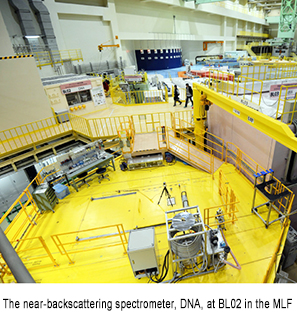 A research team made up of Senior Scientist Satoru Fujiwara and Senior Researcher Tatsuhito Matsuo of the National Institutes for Quantum and Radiological Science and Technology (QST), Osaka University, Tottori University, Kaoru Shibata (Japan Atomic Energy Agency) Assistant Manager of Research in the Neutron Science Section of the J-PARC Center, and the Comprehensive Research Organization for Science and Society (CROSS) has carried out a molecular level investigation of the movement of certain proteins in the brain closely connected with the onset of Parkinson's disease, by using the near-backscattering spectrometer, DNA, at beam line BL02 in the Materials and Life Science Experimental Facility (MLF). The team discovered, for the first time in the world, that these proteins exhibit abnormal behavior in the state where they are aggregated together in filament form. This result is expected to help elucidate the formation process of these protein aggregates which are the key to disease onset, and the mechanism of onset of the various diseases involving such formation. In this way, the research should contribute to greater control over these diseases. A research team made up of Senior Scientist Satoru Fujiwara and Senior Researcher Tatsuhito Matsuo of the National Institutes for Quantum and Radiological Science and Technology (QST), Osaka University, Tottori University, Kaoru Shibata (Japan Atomic Energy Agency) Assistant Manager of Research in the Neutron Science Section of the J-PARC Center, and the Comprehensive Research Organization for Science and Society (CROSS) has carried out a molecular level investigation of the movement of certain proteins in the brain closely connected with the onset of Parkinson's disease, by using the near-backscattering spectrometer, DNA, at beam line BL02 in the Materials and Life Science Experimental Facility (MLF). The team discovered, for the first time in the world, that these proteins exhibit abnormal behavior in the state where they are aggregated together in filament form. This result is expected to help elucidate the formation process of these protein aggregates which are the key to disease onset, and the mechanism of onset of the various diseases involving such formation. In this way, the research should contribute to greater control over these diseases. |
| The results of this research were published on April 20 (U.S. Eastern Standard Time) in the open-access international science journal PLOS ONE. For details, please see : http://journals.plos.org/plosone/article?id=10.1371/journal.pone.0151447 |
|
| ● New Findings Connected to the Development of Osteoporosis Drugs with Fewer Side Effects (Ibaraki Prefecture Neutron Beamline) |
|---|
| A research group lead by Takeshi Yokoyama, Assistant Professor, Toyama University (Graduate School of Medicine and Pharmaceutical Science, Faculty of Pharmacy and Pharmaceutical Sciences), Ichiro Tanaka, Professor, Ibaraki University (Department of Biomolecular Functional Engineering, College of Engineering), and Katsuhiro Kusaka, Professor, Ibaraki University (Frontier Research Center for Applied Atomic Sciences) has carried out a neutron crystal structure analysis of the complex of the osteoporosis drug bisphosphonate and farnesyl diphosphate synthase (FPPS), a target protein with major involvement in that disease. This work was carried out using J-PARC's Ibaraki Biological Crystal Diffractometer (iBIX) and the neutron diffractometer (BIODIFF) of the Heinz Maier-Leibnitz neutron source (FRM II) in Germany. The results showed that hydrogen atoms in the phosphate groups of bisphosphonate are removed, and the groups all assume the deprotonated state (negative ion), and there is bonding between the hydrogen in the positively charged target protein and the hydrogen in water molecules. This suggests that drugs rich in sites with high affinity for hydrogen have good efficiency as inhibitors of the target protein, and this is an important clue for the design of drugs with fewer side effects. |
| These research results were published in the U.S. Chemistry Journal of Medicinal Chemistry (ACS) in August 2015. For details, please see : http://pubs.acs.org/doi/10.1021/acs.jmedchem.5b01147 |
| *TerminologyBisphosphonate : A drug with high affinity for bone which inhibits the absorption of bone by osteoclasts |
| |
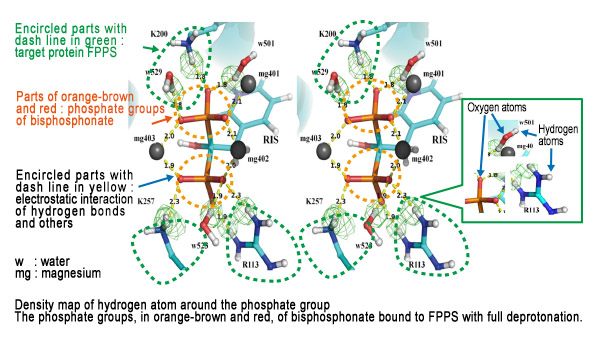
 * Click here to enlarge. * Click here to enlarge. |
| |
| ▲to Page Top |
| |
|
| ● User Visits to J-PARC (through FY2015) |
|---|
| Numerous users have visited J-PARC since facility utilization began in December 2008. Through the last day of FY2015, total user visits were 189,557 person-days. The graph at right totals the number of visitors thus far by fiscal year. In the period since FY2009, visits have been roughly 30,000 person-days in every fiscal year, except for in 2011 and 2013, when there were declines due, respectively, to the earthquake and the radioactive material leak incident at Hadron experimental facility. |
| |
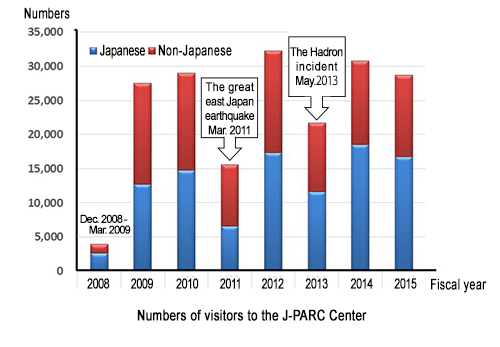
 * Click here to enlarge. * Click here to enlarge. |
| |
| ▲to Page Top |
| |
|
| ● Facility Updates |
|---|
| (1) At the Hadron Experimental Facility, a superconducting magnet used in the K1.8 beamline on the north side of the experimental hall was moved to the beamline on the south side of the hall to carry out new research proposals. |
| (2) J-PARC Center has a plan to construct a Transmutation Experimental Facility. Equipment is being arranged to demonstrate low power proton beam extraction for ADS neutronics study by the laser charge exchange technique using a laser beam and a thin foil to be used in the future. In addition, installation of a large-scale test loop has been completed for studying structural material corrosion due to liquid lead-bismuth eutectic (LBE) alloy to be used as a spallation target of the facility. |
| |

 * Click here to enlarge. * Click here to enlarge. |
| |
| ▲to Page Top |
| |
|
| ● Completion of a large-scale test loop for studying structural material corrosion due to liquid lead-bismuth eutectic |
|---|
| The OLLOCHI (Oxygen-controlled LBE LOop Corrosion tests in HIgh-temperature) has been completed. The purpose of this loop is to obtain data relating to the compatibility between various steel materials and lead-bismuth eutectic (LBE) alloy. LBE is a candidate material for spallation target as well as for coolant of subcritical reactor core for the Transmutation Experimental Facility and accelerator-driven systems (ADS). OLLOCHI is a large-scale test loop for studying structural material corrosion due to LBE under controlled oxygen concentration at a maximum temperature of 550℃. Its most remarkable feature is that the test section branches into 3 parts, and ordinary corrosion test pieces can be mounted in 2 of these parts. In the remaining part, it is plan to install equipment enabling corrosion testing while applying stress. There are multiple test sections which look like "heads," and a single main pipe which corresponds to a "body" and bends in a complex way due to thermal stress relaxation. Thus the loop resembles the "Orochi," an eight-forked serpent of Japanese legend, and it was given the name OLLOCHI. We plan to start function testing relating to LBE flow (commissioning operation and oxygen concentration control testing), and corrosion testing of steel will begin in this fiscal year, after installing flowmeters in each test section. |
| |
| ▲to Page Top |
| |
|
| ● "Time and Clocks : Experiments and Discoveries with Mom!" J-PARC Hello Science in Tokyo (March 30, Nishitokyo) |
|---|
| The Yutakagakuen Yato Kindergarten in Nishitokyo holds an extracurricular class called "Creative Thinking Workshop: Kid's Studio" where outside teachers are invited, and kindergarten and elementary school students participate in various activities aimed at developing scientific and creative thinking skills. In March 2015, the first J-PARC Hello Science event was held in Tokyo at this studio, so this was the second time for this event. As before, J-PARC public relations advisor, Dr. Shinichi Sakamoto, spoke to about 40 junior and senior high school students who graduated from the studio, including their parents. The topic was "time," and he guided them through some projects. The children asked many questions about time, like why flowers bloom at the same time every year. In response, Dr. Sakamoto described the biological clocks of animals and plants, and talked about time in general. He explained that various clocks for marking time were devised in ancient times, like sundials, water clocks and hourglasses based on natural materials like the sun, water and sand, and later mechanisms such as the verge and foliot clock were discovered as more accurate ways to measure time. Later, the participants were divided into groups and assigned projects: an hourglass for the kindergarteners, a water clock for students in the early grades of elementary school, and a difficult verge and foliot clock for high school students and above. By working together on these projects, parents and children were both able to spend some quality time interacting with science. |
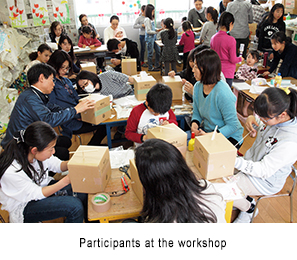 |
| |
| ▲to Page Top |
| |
|
| ● KEK Science Cafe "A Deeper Understanding of Hydrogen" (April 3, Tamarokuto Science Center, Nishitokyo) |
|---|
| A KEK Science Cafe on the theme of hydrogen was held by KEK on the 3rd at the Tamarokuto Science Center. The instructors this time were Madoka Mochida, Public Relations Coordinator at the Institute of Materials Structure Science (IMSS), and Professor Toshiya Otomo (Neutron Science Section, J-PARC) who is carrying out research on hydrogen storage alloys using the neutron instrument NOVA at the MLF. The purpose of this Science Cafe was to have all generations, from children to adults, gain a renewed understanding of hydrogen. The morning session was held for elementary and junior high school students, and the afternoon session was held for participants ranging from high school students to adults. About 40 people attended, including accompanying persons of those elementary school students. Many questions were asked in response to a wide-ranging talk mixed with quizzes, covering topics from the birth of hydrogen to the potential for utilizing hydrogen in the future. In the science experiment segment, everyone watched with great interest an experiment using soap bubbles to experience the characteristics of hydrogen, a demonstration of a model car running on hydrogen, and a hydrogen absorbing alloy which turns transparent when it takes up hydrogen. |
| The hydrogen theme of this Science Cafe was taken from a "Hydrogen" poster, planned and produced by the IMSS and published by the Ministry of Education, Culture, Sports, Science and Technology for Science and Technology Week 2016. |
| |
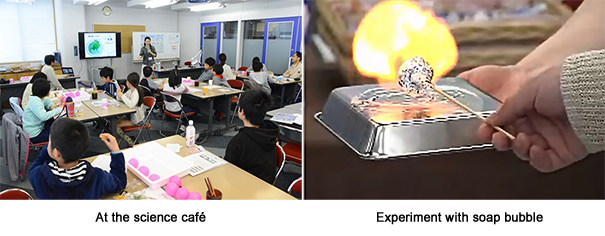 |
| |
| ▲to Page Top |
| |
|
©2016 J-PARC Center. All rights reserved.
|
|